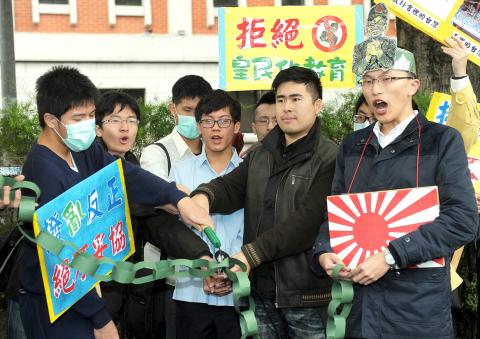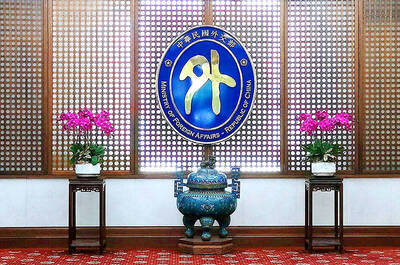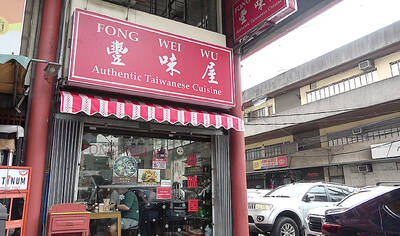A group of high-school students and young China-centered history advocates yesterday said they supported the changes the Ministry of Education (MOE) has proposed for the high-school history curriculum and urged it to stand firm against opposing views.
Following a wave of protests against the adjustments by history professors and students, political figures and high-school teachers over the past two weeks, a dozen young people, referring to themselves as the Anti-Independence-Oriented-History Front, yesterday defended the ministry.
Comprised of the Alliance of Students Safeguarding the Nation’s History, the New Youth Justice Alliance and the Association of New Chinese Children, the Front members raised banners that read: “No compromise to bringing order to chaos” and “Say No to Kominka education” in front of the ministry building in Taipei.

Photo: CNA
The Kominka movement refers to the Japanese endeavor during the Japanese colonial period to make Taiwanese loyal subjects of the emperor.
People at the rally said that the ministry’s adjustments were only to “justifiably have history written more in line with the Republic of China (ROC) Constitution” and said that they are people of ROC, not Japan’s imperial subjects.
Hou Han-ting (侯漢廷), a graduate political science student at National Taiwan University and the head of the school’s China Rise Club, said the textbook was “the execution of the will of the state” and so should teach history from the ROC’s point of view rather than from a Taiwanese independence viewpoint.
“The adjustments are only small changes to bring order to the chaos [incurred by the Democratic Progressive Party administration during its eight years in power],” Hou said.
“What’s wrong with telling the truth about Taiwanese history of Japanese persecuting Taiwanese and forcing some to become comfort women?” Hou added.
Chinese Culture University history graduate student Lin Ming-cheng (林明正) criticized the current textbook for introducing Taiwanese temples that enshrine Japanese police from the Japanese colonial period.
Lin showed pictures of Tainan City’s temples enshrining Koxinga (國姓爺) for “the re-conquest of Taiwan” and academic and bureaucrat Lin Zexu’s (林則徐) action against opium in 1838, pointing out that these cases indicated “the real Taiwanese society has a China-centered view of history.”
New Chinese Children Association head Wang Puchen (王炳忠) said critics who accused the MOE of acting to “de-Taiwanize” the nation had “blemished” the government’s effort, adding that the changes are not to devalue Taiwan, but to get rid of Kominka thinking.
“Real Taiwanese history can be seen as the history of modern China being encroached by colonial empires,” Wang said, adding that localization is not equal to Taiwanese independence.
Hou, Lin and Wang were the leaders of the movements supporting pro-China Want Want China Times Group in last year's media monopolization controversy.

The Ministry of Foreign Affairs (MOFA) yesterday voiced dissatisfaction with the Comprehensive and Progressive Agreement for Trans- Pacific Partnership (CPTPP), whose latest meeting, concluded earlier the same day, appeared not to address the country’s application. In a statement, MOFA said the CPTPP commission had "once again failed to fairly process Taiwan’s application," attributing the inaction to the bloc’s "succumbing to political pressure," without elaborating. Taiwan submitted its CPTPP application under the name "Separate Customs Territory of Taiwan, Penghu, Kinmen and Matsu" on Sept. 22, 2021 -- less than a week after China

THE GOOD WORD: More than 100 colleges on both sides of the Pacific will work together to bring students to Taiwan so they can learn Mandarin where it is spoken A total of 102 universities from Taiwan and the US are collaborating in a push to promote Taiwan as the first-choice place to learn Mandarin, with seven Mandarin learning centers stood up in the US to train and support teachers, the Foundation for International Cooperation in Higher Education of Taiwan (FICHET) said. At the annual convention of the American Council on the Teaching of Foreign Languages held over the weekend in New Orleans, Louisiana, a Taiwan Pavilion was jointly run by 17 representative teams from the FICHET, the Overseas Community Affairs Council, the Steering Committee for the Test of Proficiency-Huayu, the

A home-style restaurant opened by a Taiwanese woman in Quezon City in Metro Manila has been featured in the first-ever Michelin Guide honoring exceptional restaurants in the Philippines. The restaurant, Fong Wei Wu (豐味屋), was one of 74 eateries to receive a “Michelin Selected” honor in the guide, while one restaurant received two Michelin stars, eight received one star and 25 were awarded a “Bib Gourmand.” The guide, which was limited to restaurants in Metro Manila and Cebu, was published on Oct. 30. In an interview, Feng Wei Wu’s owner and chef, Linda, said that as a restaurateur in her 60s, receiving an

Kaohsiung Mayor Chen Chi-mai (陳其邁) on Monday announced light shows and themed traffic lights to welcome fans of South Korean pop group Twice to the port city. The group is to play Kaohsiung on Saturday as part of its “This Is For” world tour. It would be the group’s first performance in Taiwan since its debut 10 years ago. The all-female group consists of five South Koreans, three Japanese and Tainan’s Chou Tzu-yu (周子瑜), the first Taiwan-born and raised member of a South Korean girl group. To promote the group’s arrival, the city has been holding a series of events, including a pop-up